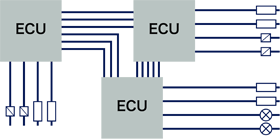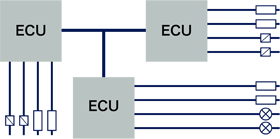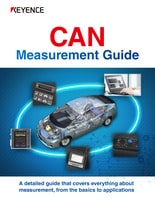What Is CAN?
This section explains the “CAN,” a communication protocol used not only for automobiles but also for FA industrial equipment.
History of CAN
The controller area network (CAN) is a serial communication protocol developed by the German company Bosch. The word CAN may remind many people of automobiles. This protocol was completed in 1985 and was first adopted in mass-produced cars in 1990. Then, in 1994, the International Organization for Standardization (ISO) standardized it as ISO 11898 and ISO 11519. Today, the protocol is adopted on almost all automobiles. Furthermore, CAN is being utilized in a wide variety of fields including factory automation (FA).
Necessity of CAN
CAN was originally developed to be utilized within automobiles, but now this technology is utilized at factories, as well as on medical and other worksites. The background behind this technology was the necessity to support an increasing number of electronic control units (ECUs) in parallel with performance enhancement of automobiles. More complicated control means more I/Os and larger ECUs, and data sharing among multiple ECUs also increases the number of wires. These factors will lead to complicated, heavier automobiles with more components, which will require much higher production costs. A solution for this situation was CAN serial communication protocol that enables high-speed and reliable communication with a small number of wires.
Conventional communication method

- A large number of wires
- More weight
- Need to secure enough wiring space
- An increased number of physical wires increases the risk of faults
- Fault diagnosis requires each ECU to be inspected separately
CAN-based communication method

- Connection is possible with a small number of harnesses
- Easy communication between ECUs
- High scalability
- One piece of information can be shared between multiple ECUs
- Fault diagnosis and processing for the entire network can be done at a single location.
Types of communication protocols
In addition to CAN, other communication protocols−including the LIN, the FlexRay, and the MOST−are also used in on-board networks. The LIN, which is intended to be used as a CAN subnetwork, is a standard that enables serial communication at low cost. On the other hand, the FlexRay, which has received attention as a next-generation on-board network, enables faster communication than CAN. While CAN, the LIN, and the FlexRay are mainly used for communication to control engines, the Media Oriented Systems Transport (MOST) is intended for multi-media system communication. As outlined here, there are various communication protocols in addition to CAN.
| Communication protocol | Maximum communication speed |
|---|---|
| CAN | 1 Mbps |
| LIN | 20 kbps |
| FlexRay | 10 Mbps |
| MOST | 24.8 Mbps (standards for 50 Mbps and 150 Mbps also exist) |
As shown above, each protocol offers different communication speeds. However, the faster the communication protocol, the higher the cost, so you need to select an appropriate one according to your requirements.
Types of CAN
CAN is classified according to the communication speed into the high-speed CAN “CAN-C”, the low-speed CAN “CAN-B,” etc. Furthermore, the Society of Automotive Engineers (SAE) classifies CAN based on the communication speed as follows.
| Class | Communication speed | Applications |
|---|---|---|
| Class A | Up to 10 kbps | Lights, power windows, door locks, etc. |
| Class B | 10 to 125 kbps | Meters and other status information systems such as those for automatic air conditioners and fault diagnosis |
| Class C | 125 kbps to 1 Mbps | Real-time control systems for engines, transmissions, brakes, etc. |




